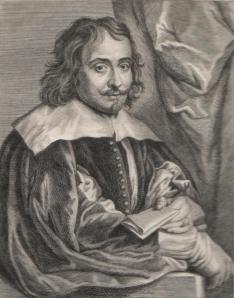 Posterity has not been altogether kind to Balthazar Gerbier. Living in the unsettled and insecure world of 17th century Europe, he often appeared to his contemporaries as a suspect figure: a jack-of-all-trades, and despite his undoubted talents, not someone to be taken seriously. Since then, historians – including his biographers – have often tended to portray him as something of a scoundrel, or at best a ‘colourful character’. In the present day, he is acknowledged as a not entirely minor figure in the history of art patronage and collecting, and in the last few years writers have paid him a certain amount of attention as a diplomat, educator and explorer of the New World. It’s generally agreed that his long and wide-ranging career meant that he encountered virtually Everyone of interest: artists, courtiers, politicians, merchants, craftsmen, writers, projectors, architects, theorists, politicians, and religious dissidents. Gerbier knew the people at the heart of the Establishment, and also the rank outsiders.
Posterity has not been altogether kind to Balthazar Gerbier. Living in the unsettled and insecure world of 17th century Europe, he often appeared to his contemporaries as a suspect figure: a jack-of-all-trades, and despite his undoubted talents, not someone to be taken seriously. Since then, historians – including his biographers – have often tended to portray him as something of a scoundrel, or at best a ‘colourful character’. In the present day, he is acknowledged as a not entirely minor figure in the history of art patronage and collecting, and in the last few years writers have paid him a certain amount of attention as a diplomat, educator and explorer of the New World. It’s generally agreed that his long and wide-ranging career meant that he encountered virtually Everyone of interest: artists, courtiers, politicians, merchants, craftsmen, writers, projectors, architects, theorists, politicians, and religious dissidents. Gerbier knew the people at the heart of the Establishment, and also the rank outsiders.
But although the outlines of his life are known well enough, many assumptions about him have remained untested, and while I would not wish to make any extravagant claims for him, it is arguable that a number of aspects of Gerbier’s life and activities deserve re-examination. His origins, upbringing and beliefs, as well as his extensive body of written work, need to be considered more thoroughly. His first major publication, the Eer Ende Claght-Dicht of 1620, is the starting point here, and perhaps an appropriate one, since of all his published works, this is the least accessible.
A Website/Blog seems the best way to do it. By dipping into his life and work at various points, and without following a strictly chronological framework, I hope it will be possible to explore aspects of his career and the circles in which he moved, as well as some neglected sources. Hopefully we shall then have a slightly more nuanced understanding of this remarkable man, and the undoubtedly troubled times in which he lived.
(Picture – from an engraving by Thomas Chambars, after van Dyck.)

This looks very promising – I know that you have been working on Sir B for a long time, and it is good to see him re-appear, even if in a very different world.
I fear the language of EEC-D is beyond me though…
Hi, I am very interested in Sir B as he came to England in the train of my ‘man’ Sir Noel de Caron. It would seem logical that he may have painted the ambassador whilst he was in England. Do you have any information on his paintings – I know he painted Buckingham, but that is as far as my research takes me.
Hi Bobby – Sir Noel must have done a good deal for Gerbier when he arrived in England, and it would seem quite natural for him to depict his patron in one form or another. One strand of Gerbier’s activities that I’m trying to sort out is the question of his artistic work, and while various portraits in oils have been attributed to him, none of the attributions seems very convincing, and I’ve certainly not met with any such depiction of Sir Noel. The works definitely attributable to Gerbier all appear to be either painted miniatures or drawings, signed by him, and consistent in style. There must be a number of lost works too – for example the pictures of his daughters that visitors to his house remarked on, and drawings owned by Amsterdam collectors, noted in auction records. His highly finished drawings ( e.g. those in the British Museum collection) are reminiscent of prints by Simon de Passe, who also came to England in 1616, and there’s some evidence that he and Gerbier may have collaborated on some images. While I’ve not found a direct reference to a portrait of Sir Noel, there may be an engraving lurking in one of the major print collections. Artists like de Passe produced many such prints of notable contemporaries. If I come across anything that seems possibly to relate to him I’ll be sure to let you know.
Sorry, for such a VERY late reply. Thanks, would be grateful if you could let me know if you come across anything.